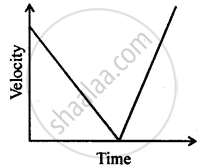Advertisements
Advertisements
प्रश्न
The figure shows the displacement - time graph for four bodies A, B C and D. In each case state what information do you get about the acceleration (zero, positive or negative).

उत्तर
For body A: The graph is a straight line. So, the slope gives constant velocity. Hence, the acceleration for body A is zero.
For body B: The graph is a straight line. So, the slope gives constant velocity. Hence, the acceleration for body B is also zero.
For body C: The slope of the graph is decreasing with time. Hence, the acceleration is negative.
For body D: The slope of the graph is increasing with time. Hence, the acceleration is positive.
APPEARS IN
संबंधित प्रश्न
Which of the two can be zero under certain conditions : average speed of a moving body or average velocity of a moving body ?
Fill in the following blank with suitable word :
Velocity is the rate of change of……………………… It is measured in.............. .
A bus running at a speed of 18 km/h is stopped in 2.5 seconds by applying brakes. Calculate the retardation produced.
When a car driver travelling at a speed of 10 m/s applies brakes and brings the car to rest in 20 s, then retardation will be :
A car starting from rest acquires a velocity 180m s-1 in 0.05 h. Find the acceleration.
Derive the following equations for uniformly accelerated motion:
(i) v = u + at
(ii) `"S = ut" + 1/2 "at"^2`
(iii) v2 = u2 + 2aS
where the symbols have their usual meanings.
Multiple choice Question. Select the correct option.
The speed of a car reduces from 15 m/s to 5 m/s over a displacement of 10 m. The uniform acceleration of the car is :
Multiple choice Question. Select the correct option.
At the maximum height, a body thrown vertically upwards has :
Can you suggest a real-life example about the motion of a body from the following velocity – time graph?

How will the equations of motion for an object moving with a uniform velocity change?
